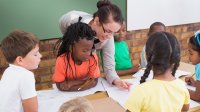Learning to Recognize and Celebrate Students’ Cultural Experiences
Children of color often come to school with differences in language and customs that some teachers see as deficits.
Your content has been saved!
Go to My Saved Content.After teaching in both Harlem and New Orleans, I have seen many BIPOC (Black, Indigenous, and people of color) students face the same tragic challenge, that schools view their differences in cultural background and language as weaknesses. Teachers have the power to shift their focus from what a student lacks to the vast array of experiences and diversity that such students bring. Teachers can focus on differences in their classrooms instead of deficits.
Every student who enters a classroom should feel that they have every opportunity to become successful. Students who come from backgrounds dissimilar to the majority’s, however, often do not feel this way. When teachers do not actively employ culturally responsive practices and work to challenge students by understanding their strengths, teachers may communicate to these students that they are not welcome or capable of success.
In one particular example, a Native American student, like many students of color in public schools today, was viewed as incapable of accessing and mastering the material. He was wrongly seen as disadvantaged when he should have been seen as different. The skills he had learned from a young age—mastering his native language, an in-depth understanding of the environment around him, firsthand experience with a number of traditional Native American ceremonies—were not easily translated into the classroom and therefore were disregarded by his teachers.
Many students come into a classroom with an array of experiences and skills but learn to believe that these are useless when they cannot apply them to the classroom. These students therefore struggle in their classes because the curriculum is not responsive to their cultural and linguistic needs.
Often, this leads to BIPOC students being disproportionately referred for special education evaluations and interventions. These students are then labeled as learning disabled when the problem is not their learning ability but the curriculum they are being judged against.
This problem predominantly affects African American and Hispanic students. This issue of misclassification not only is detrimental to those students who are told that they have a disability when they do not, but also harms those students who actually should be classified as having special learning needs when resources are incorrectly allocated.
Changing the Curriculum
In order to fight against this problem of misclassification and misleading students to believe that they are incapable, teachers must ensure that their curriculum is responsive to the needs of their students. Because all students may not have experience in a traditional classroom setting prior to kindergarten, it is critical that teachers work with these students to identify their strengths and areas of growth as they enter the classroom. From there, teachers can identify ways to highlight the unique experiences and skills that these students bring.
To gain a better understanding of the backgrounds of students, teachers must invest time and energy into developing trusting relationships with both students and their families. This allows teachers to better align their classroom instruction and expectations with those of the family and the relevant cultural backgrounds. With this knowledge, teachers can also identify ways to include students’ identities in the curriculum. This can look like including literature about and by those who identify as the cultures in the class, scaffolding material so that it reflects the prior knowledge of students, or including references to things that the students can relate to. Teachers will need to learn about their individual students to make this happen.
In my own classroom, this often looked like altering the context of given mathematical word problems to better align with my students’ individual experiences; living in New York City, many of my students were particularly gifted with navigational skills and spatial awareness, which I was able to utilize when teaching geometry and the coordinate plane. These instructional shifts not only will communicate to students that their culture is valuable to the classroom but also will allow them to find more success with the content when they are able to make personal connections and utilize their previous knowledge to develop an understanding of new content.
Because all students are different, teachers must continually work to ensure that their instructional decisions reflect the experiences and values of those they teach. There is no one-size-fits-all curriculum, and teachers should not attempt to create one. Students bring their individual experiences and skills to the classroom, and teachers must ensure that they allow students to embrace these experiences and skills in order to find success. Doing so will ensure that these students are not disproportionately identified as learning disabled and will allow them to thrive in a classroom that recognizes and values their differences as opposed to one that views those differences as deficits.
